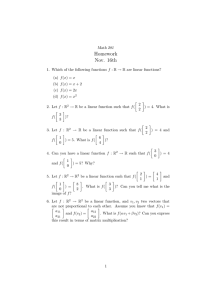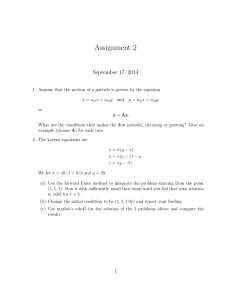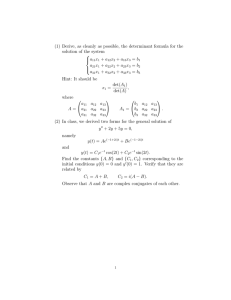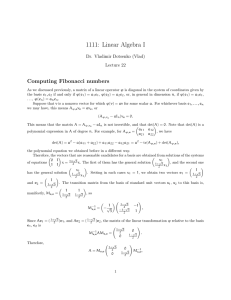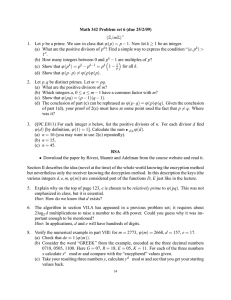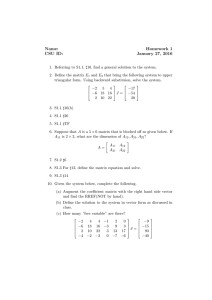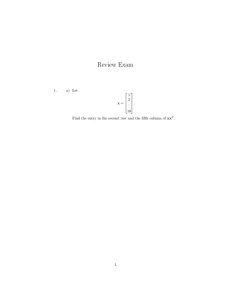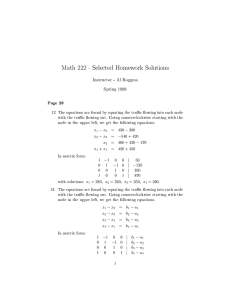Calculus III Part 2 Name: Solutions
advertisement
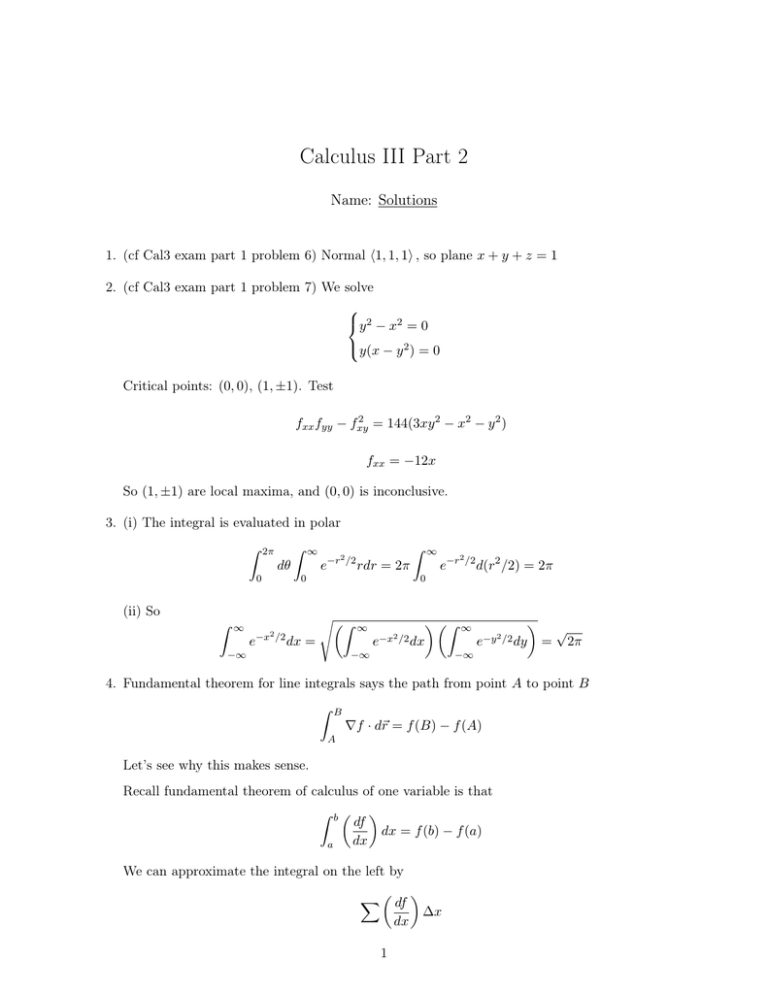
Calculus III Part 2
Name: Solutions
1. (cf Cal3 exam part 1 problem 6) Normal h1, 1, 1i , so plane x + y + z = 1
2. (cf Cal3 exam part 1 problem 7) We solve
y 2 − x2 = 0
y(x − y 2 ) = 0
Critical points: (0, 0), (1, ±1). Test
2
fxx fyy − fxy
= 144(3xy 2 − x2 − y 2 )
fxx = −12x
So (1, ±1) are local maxima, and (0, 0) is inconclusive.
3. (i) The integral is evaluated in polar
ˆ
ˆ
2π
∞
dθ
0
(ii) So
ˆ
∞
e
−x2 /2
e
−r2 /2
ˆ
∞
rdr = 2π
0
e−r
2 /2
d(r2 /2) = 2π
0
sˆ
∞
e−x2 /2 dx
dx =
−∞
ˆ
∞
−∞
e−y2 /2 dy
=
√
2π
−∞
4. Fundamental theorem for line integrals says the path from point A to point B
ˆ
B
∇f · d~r = f (B) − f (A)
A
Let’s see why this makes sense.
Recall fundamental theorem of calculus of one variable is that
ˆ b df
dx = f (b) − f (a)
dx
a
We can approximate the integral on the left by
X df dx
1
∆x
Since df /dx is the slope of the tangent,
df
dx
∆x = ∆f , and adding all the ∆f gives f (b)−f (a).
Graphically
For line integral, let’s approximate the integral as
ˆ
B
∇f · d~r ≈
X
(∇f ) · ∆~r
A
Recall in Cal3 exam part 1 problem 6, we said that
∂f
∂f
∂f
∆x +
∆y +
∆z = (∇f ) · ∆~r
∂x
∂y
∂z
∆f =
so adding all the ∆f (they are all scalar now) gives
ˆ
B
∇f · d~r ≈
X
∆f = f (B) − f (A)
A
For our problem
F~ = ∇f,
f=
y2
x
+ eyz + z 2
+1
f is unique up to an additive constant, independent of x,y and z. So
ˆ
F~ · d~r = f (1, 0, 2π) − f (1, 0, 0) = 4π 2
5. Stokes says
˛
¨
F~ · d~r =
C
~
curl F~ · dS
A
where A is any area whose boundary is C.
~ is along
If C lies entirely on the xy plane, then A can be chosen to be on the xy plane, so dS
ẑ direction only, so only the ẑ component of curl F~ matters. Therefore
˛
F~ · d~r =
C
¨ A
∂Fy
∂Fx
−
∂x
∂y
dS
which is the Green’s theorem. We don’t have to memorize Green, for it is a special case of
Stokes.
However Stokes is derived from Green, because assuming Green is correct, then for any given
C and A, we just project them onto the xy plane, yz plane, and zx plane, we get 3 Green
2
equations. Adding the 3 equations, the area integrand becomes curl of F~ , and the 3 equations
turn into dot product, which in turn gives Stokes.
Let’s see why Green makes sense. Suppose C is on the xy plane, and let A be the area enclosed
by C on xy plane and assume that we can chop S into many and many tiny rectangles with
sides ∆x, ∆y.
Let us look at one of the tiny rectangles whose four corners are (x, y), (x + ∆x, y), (x, y + ∆y),
and (x + ∆x, y + ∆y).
¸
~ · d~r for this tiny rectangle counterclockwise. Denote F~a , F~b , F~c , F~d
to be the vector F~ on the four sides (and Fax means the x component of F~a , etc.), then
Let us compute
tiny F
˛
F~ · d~r = Fax ∆x + Fby ∆y − Fcx ∆x − Fdy ∆y
tiny = (Fax − Fcx )∆x + (Fby − Fdy )∆y
∂Fy
∂Fx
= −
∆y∆x +
∆x∆y
∂y
∂x
∂Fy
∂Fx
=
−
∆x∆y
∂x
∂y
Now summing all tiny rectangles on S,
X˛
X ∂Fy
F~ · d~r =
∂x
tiny The left hand side becomes
−
∂Fx
∂y
∆x∆y
˛
F~ · d~r
C
because all internal line integrals cancel, for internal edges of the rectangles are common edges
of the two adjacent rectangles, and the line integrals are running in opposite directions. Only
3
the boundary C survives; while the right hand side gives
¨ ∂Fy
∂Fx
−
∂x
∂y
A
dS
showing Green is right.
For our problem, the integral is
¨
ˆ
ˆ
1
3
ydy = 16
dx
2ydA = 2
−1
1
6. Question: Shall we use Stokes or Gauss’s?
• Let us see the Stokes’ way.
¨
Consider
~
n̂ · dS
surface area of A =
A
where A is the surface x2 + y 2 + z = 2 above the xy plane, and n̂(x, y, z) is the unity vector
~ i.e.
whose direction is equal to dS,
h2x, 2y, 1i
n̂ = p
4x2 + 4y 2 + 1
Now we put curl F~ = n̂ for some F~ . We have
¨
˛
~=
curl F~ · dS
surface area of A =
A
F~ · d~r
C
where C = {(x, y, z)|x2 + y 2 = 2, z = 0}.
˛
We know from Stokes
¨
F~ · d~r =
~
curl F~ · dS
A0
C
where A0 is any area whose boundary is C. For convenience we choose A0 = {(x, y, z)|x2 +y 2 ≤
2, z = 0}. We find
¨
¨
~ =
n̂ · dS
surface area of A =
A0
A0
1
p
dS = 2π
4x2 + 4y 2 + 1
ˆ
√
2
√
0
r
dr = π
4r2 + 1
Everything looks good except this is not correct. It is not correct because there is no such F~
so that
h2x, 2y, 1i
curl F~ = n̂ = p
4x2 + 4y 2 + 1
To see why, let’s take divergence to both sides
∇ · (∇ × F~ ) = ∇ · n̂
4
Since divergence of curl is identically equal to zero, but
∇ · n̂ = 4
2x2 + 2y 2 + 1
6= 0
(4x2 + 4y 2 + 1)3/2
What can we do? Stokes is certainly not applicable. We should have checked that if
∇ · n̂ = 0
before we went on to do all the calculations. Fortunately as we’ll see, most of the hard
calculations above are recyclable in Gauss’s way. We now switch to Gauss’s way.
• Gauss’s way
We take a closed surface
A ∪ A0
where A is the surface x2 +y 2 +z = 2 above the xy plane, and A0 = {(x, y, z)|x2 +y 2 ≤ 2, z = 0},
as defined earlier.
Applying Gauss to A ∪ A0 , we get
‹
˚
~=
n̂ · dS
A∪A0
(∇ · n̂)dV
V
where n̂ is also defined earlier.
Left hand side is
¨
~ = surface area of A − π
n̂ · dS
surface area of A +
A0
The minus sign in the front of π is due to the fact that we define outward normal flux to be
positive as in Gauss’. (We will show in the next problem why this is a natural way to define
the direction of a closed surface.)
Right hand side is computed in cylindrical coordinate
ˆ
8π
ˆ
√
2
2−ρ2
ρdρ
0
dz
0
2ρ2 + 1
10π
=
3/2
2
3
(4ρ + 1)
So
surface area of A =
13π
3
In summary
~ such that B
~ = curl A
~ iff div B
~ = 0, then we can apply Stokes
(a) We have seen that ∃ A
~ (Those who have taken general physics II may have recognized
to the vector field B.
~ is the magnetic field, and A
~ is the vector
that the physical prototype here is that B
5
~ = 0 is equivalently to say there is no magnetic monopole (i.e. no
potential. That div B
free stand positive or negative magnetic charges) so magnetic field lines are always closed,
i.e. curly looking.) Important to notice, closed vector lines (such as magnetic fields) have
0 divergence, however 0 divergent fields may not consist of closed lines, nor it contains
any curly lines. cf. problem 9(viii)
~ = ∇φ iff
(b) Here is a parallel statement to above, that ∃ a scalar function φ such that E
~ = 0. (One may have recognized that the physical prototype for E
~ is the electrocurl E
~ is conservative, and electrostatic
static field, and φ is the electrostatic potential. So E
field lines are always coming out of positive charges and ending at negative charges, so
if we put the negative charges at ∞, the field produced by a single positive charge looks
likes diverging to ∞.)
(c) We now show the connection between the fundamental theorem for line integrals, Stokes’
and Gauss’. Say starting from Gauss’
‹
˚
(∇ · F~ )dV,
~=
F~ · dS
A
V
we change F~ to F~ + F~ 0 for any arbitrary vector field F~ 0 such that ∇ · F~ 0 = 0. The right
hand side of Gauss is clearly unchanged, but what about the left hand side? The LHS is
‹
now
‹
~
F~ 0 · dS
~+
F~ · dS
A
Because
F~ 0
A
~ for some vector A,
~ (by (a) above) Applying Stokes to the second
= curl A
term shows it is zero.
Physically this means that in computing the flux, adding some other flux F~ 0 , which has
∇ · F~ 0 = 0 inside of V , makes no difference. Because that ∇ · F~ 0 = 0 inside of V means
no sources or sinks that produce or terminate F~ 0 are inside of V , all fluxes that go into
V must come out of V . (divergence of magnetic field is always zero everywhere means
there is no magnetic charges.)
Recall in the solution to problem 6, we first calculated
¨
~=π
n̂ · dS
A0
in the Stokes way, but then we did the same calculation in Gauss way, we got
¨
~ = −π
n̂ · dS
A0
This flip of sign is what makes Stokes’ and Gauss’ consistent to each other.
Now we write down Stokes
˛
¨
F~ · d~r =
C
~
curl F~ · dS
A
6
and add F~ 0 to F~ for any arbitrary F~ 0 such that curl F~ 0 = 0, then the RHS is clearly
unchanged, while the LHS is also unchanged due to the fundamental theorem for line
integrals, because F~ 0 = ∇f for some scalar function f . (see (b) above) Physically this
means that the additional work done by F~ 0
˛
F~ 0 · d~r
C
is zero, because F~ 0 is conservative.
[Extra Credits for those who know surface parametrization: calculate the surface area, using
the following parametrization
~γ (u, v) = u cos v, u sin v, 2 − u2
u ∈ [0,
√
2], v ∈ [0, 2π]
and compute
~γu , ~γv , |~γu × ~γv |
Then compute
ˆ
surface area of A =
ˆ
dv
du|~γu × ~γv |
Should give the same answer, and much faster.]
7. Let’s see why Gauss’ makes sense. The discussion is almost parallel to Green’s. Suppose V is
the volume in Gauss’ and assume that we can chop V into many and many tiny cubes with
sides ∆x, ∆y, ∆z.
Let us look at one of the tiny cubes whose 8 vertices are (x, y, z), (x + ∆x, y, z), (x, y + ∆y, z),
... , and (x + ∆x, y + ∆y, z + ∆z).
‚
~ for this tiny cube. Denote F~l , F~r , F~u , F~d , F~f , and F~b
Let us compute one tiny cube F~ · dS
to be the vector F~ on the left, right, up, down, front, and back sides (and Flx means the x
component of F~l ), and our coordinate system is chosen such that x+ to the front, y+ to the
right, and z+ up, and choose outward normal to be the positive flux direction, then
‹
~ = (Fry − Fly )∆x∆z + (Ff x − Fbx )∆y∆z + (Fuz − Fdz )∆x∆y
F~ · dS
one tiny cube
= (
∂Fx ∂Fy
∂Fz
+
+
)∆x∆y∆z
∂x
∂y
∂z
Notes:
(a) The end result is celebrated divergence. This shows why we choose outward normal to
be positive flux. If we chose mix direction on each side of cube, we would mess up. The
same principle applies to Stokes, where right hand rule is the right choice.
(b) In the calculation above we used one value (e.g. Flx , etc ) for each face. You may wonder
0 (x∗ )∆x + ... for each face, and
what if we use better approximation such as Flx (x∗ ) + Flx
7
do integration on each face. But the higher order corrections eventually give 4th order
correction at the end. They are not compatible to our 3rd order correction, so we don’t
have to keep them. (cf Cal3 exam part 1 solution problem 7 b). The same logic applies
to our ”proof” of Stokes.
Now summing all tiny cubes in V ,
X‹
~=
F~ · dS
one tiny cube
The left hand side becomes
X ∂Fx ∂Fy
∂Fz
(
+
+
)∆x∆y∆z
∂x
∂y
∂z
‹
~
F~ · dS
A
because all internal flux integrals cancel, for internal faces of the rectangles are common faces
of the two adjacent cubes, and the flux integrals are running in opposite directions. Only the
boundary A survives; while the right hand side gives
˚ ∇ · F~ dV
V
showing Gauss is right.
Notes:
(a) In the ”proof” above, to greatly simplify the left hand side, we use a quite peculiar
argument that the internal flux integrals cancel, only boundary survives. Because of this
argument, we can easily extend Gauss to region V not a solid, but has holes in it, and we
just have to do additional flux integral evaluation on the boundary of the internal holes.
The same principle applies to Stokes and Greens, where regions A, not necessary simple
connected, with holes, are too allowed.
(b) However there are examples like Möbius strip and Klein bottle. We can chop the region
into many and many tiny loops/cubes (the main idea of Calculus) and we are able to
define the direction of positive line/flux integral for each little element, but what happens
at the local level may not descent the global structure of the shape. Möbius strip does not
work in Stokes, because it has no well-defined orientation. We know the functioning of
right hand rule is crucial for the internal line integrals to cancel (see our ”proof” above).
For Klein bottle, we cannot distinguish the internal and external, i.e. the direction of
outward normal positive flux is not well-defined, but we need this for the internal Gauss
flux integrals to cancel.
(c) On the right hand side, the step where we turn
P
x
( ∂F
∂x +
∂Fy
∂y
z
+ ∂F
∂z )∆x∆y∆z into is very
common, but if we pause for a minute to think about it, we see that the step going from
∆x∆y∆z → dV
is too very interesting. Because ∆x∆y∆z, (as well as our ”proof”) refers to Cartesian
8
coordinates, but dV has no explicit reference to any coordinates, namely we can evaluate
˚ ∇ · F~ dV
V
in any coordinates we like. The same principle applies to Stokes.
For our problem, the integral is
ˆ
1
r4 dr =
4π
0
4π
5
8. (i) vector field on x axis is h0, −xi, so it is (h);
(ii) vector field on y axis is h0, 1i, so it is (b);
(iii) vector field on y axis is h0, yi and on x axis is hx, 0i, so it must be one of (e), (d), or (g),
but only (e) is symmetric with respect to x and y, so it is (e);
(iv) Similar to above, for large x > 0 value the x component is much bigger than y component.
So it is (d);
(v) This is to change the y component of (iii) from positive to negative, so it is (f).
9. (i) No.
(ii) Yes.
(iii) Yes.
(iv) Should read C is a simple closed “counterclockwise” curve... ANS: Yes, by Green.
(v) Yes.
(vi) Yes.
(vii) Yes.
Let us do (ix) before (viii).
(ix) Yes, we can just compute
curl F~ = curl hx, −yi = 0
Therefore by Green’s, taking a closed loop of any size at anywhere, the line integral is zero,
although it is no so clear just by looking.
(viii) Yes. Can we compute div F~ now?
We don’t know the exact form of F~ , but we know it has no y component, and the x component
depends only on y, namely
F~ = hP (y), 0i
so div F~ = 0.
There is an alternative way to solve this problem. In (ix), it is hard to tell line integral is zero
by looking. However it is clear that here the flux integral is zero of closed surfaces of any sizes
9
at anywhere. Let me be more clear what I mean by “closed surfaces” in this 2 dimensional
context.
We know Green is the 2-dimensinal version of Stokes, analogously there is a 2-dimensional
version of Gauss. Let’s see what 2-dimensional version of Gauss is.
Consider a generic 2 dimensional vector, and we elevate it to 3 dimensional
F~ = hP (x, y), Q(x, y), 0i
Now apply usual Gauss’ to it, and choose V the volume in the integral to be a pillbox, whose
top and bottom surfaces are parallel to the xy plane. So no flux on these two surfaces, and
the flux on the side of the pillbox are constant in z.
For our problem, if we take such pillbox of any size at anywhere, then the flux integral is
clearly zero. Hence divergence is 0.
(x) No, can be saddle points.
Counterexample: find max or min of
V = y − x3
subject to
y = x5
p
Lagrange gives critical points x = ± 3/5, and x = 0. The first two are local max and min,
and the last one is a saddle point.
Let’s see why Lagrange makes sense.
Warning: you are headed six pages of long proof!! You are advised not to read it if you are
pressed for time, since it is not required for Cal 3. However this proof is the most elementary
version I can show you and use only the material up to Cal 3. (That is why it is so long.) If
you wish, skip straight to the conclusion, last paragraph on the last page.
Let us consider one constraint problem
V = V (x, y)
subject to
f (x, y) = 0
Proof. We can parametrize the curve given by f (x, y) = 0 as
~γ (t) = hx(t), y(t)i
10
then our task becomes to find t so that V (t) = V (x(t), y(t)) is optimal, hence
dV
∂V ∂x ∂V ∂y
= 0 =⇒
+
=0
dt
∂x ∂t
∂y ∂t
Moreover taking t derivative of the equation f (x, y) = 0, we get
∂f ∂x ∂f ∂y
df
= 0 =⇒
+
=0
dt
∂x ∂t
∂y ∂t
The two equations above look very much like a system of two linear equations
a x + a x = 0 (1a)
11 1
12 2
a x + a x = 0 (1b)
21 1
22 2
where a11 =
∂V
∂x ,
a12 =
∂V
∂y
, a21 =
∂f
∂x ,
a22 =
∂f
∂y ,
x1 =
∂x
∂t ,
and x2 =
(1)
∂y
∂t .
We can easily guess
that one solution to the linear system is
x1 = x2 = 0
Unfortunately this is not what we want, because we have a lot of freedom in choosing parametrization. More specifically the optimal point is independent of what parametrization is chosen.
Most of time we choose regular parametrization, namely
0
~γ (t) =
∂x ∂y
,
∂t ∂t
is never ~0. So we insist that there must be other solutions to the linear system (1a) & (1b).
We claim that there exists other solutions to the linear system (1a) & (1b), iff
ha11 , a12 i = λ ha21 , a22 i
(2)
for some constant λ (λ could be 0).
Let’s prove equation (2).
Let us assume at least one of a21, a22 is not 0. (Because if both are 0, then the constraint
f (x, y) is just a constant function, which means there is no constraint. So to optimize V is of
course to set
a11 = a12 = 0
then equation (2) is automatically satisfied. This slows why Lagrange multiplier is written as
∇V = λ∇f , not λ∇V = ∇f , i.e. ∇f = ~0 =⇒ ∇V = ~0, not the another way around.)
Let’s assume a21 6= 0. (If in fact a21 = 0 and a22 6= 0, we can exchange the role of a21 ↔ a22 ,
x1 ↔ x2 , and a11 ↔ a12 , so the following analysis will work exactly the same and equation (2)
will too be the same.)
11
Now replace (1a) by a new equation obtained by multiplying (1b) by a11 /a21 then subtract it
to (1a)
a x + a x = 0
11 1
12 2
a x + a x = 0
21 1
22 2
0 + a0 x = 0
(3a)
12 2
→
a x + a x = 0 (3b)
21 1
22 2
(3)
where a012 = a12 − a11 a22 /a21 .
From (3a), if a012 6= 0, then x2 = 0, then by (3b) since a21 6= 0, x1 = 0. This shows a012 = 0,
hence
a12 − a11 a22 /a21 = 0
This shows if a11 = λa21, then a12 = λa22 , proving equation (2).
Let us consider two constraint problem of three variables
V = V (x, y, z)
subject to
f (x, y, z) = 0, g(x, y, z) = 0
Proof. We can parametrize the interaction of f (x, y, z) = 0, g(x, y, z) = 0 as
~γ (t) = (x(t), y(t), z(t))
(this requires that the interaction is a curve, not a surface. This in turn requires that ∇f is
not parallel to ∇g. This includes the case that neither ∇f = ~0 nor ∇g = ~0.)
Then our task becomes to find t so that V (t) = V (x(t), y(t), z(t)) is optimal, hence
∂V ∂x ∂V ∂y ∂V ∂z
dV
= 0 =⇒
+
+
=0
dt
∂x ∂t
∂y ∂t
∂z ∂t
Moreover taking t derivative of f (x, y, z) = 0, g(x, y, z) = 0, we get two more equations
df
∂f ∂x ∂f ∂y ∂f ∂z
=
+
+
= 0,
dt
∂x ∂t
∂y ∂t
∂z ∂t
dg
∂g ∂x ∂g ∂y ∂g ∂z
=
+
+
=0
dt
∂x ∂t
∂y ∂t
∂z ∂t
We can write above as system of three linear equations
a x + a12 x2 + a13 x3 = 0 (4a)
11 1
a21 x1 + a22 x2 + a23 x3 = 0 (4b)
a x + a x + a x = 0 (4c)
31 1
32 2
33 3
where a11 =
∂V
∂x ,
a21 =
∂f
∂x ,
a31 =
∂g
∂x ,
x1 =
∂x
∂t ,
12
(4)
etc. Because we choose regular curves, there
must be other solutions to the linear system. We will show this implies
ha11 , a12 , a13 i = λ ha21 , a22 , a23 i + µ ha31 , a32 , a33 i
(5)
for some constants λ, µ (either or both could be zero).
Let’s see why.
Assume a21 6= 0 (because ∇f 6= ~0 and likewise we can exchange the role of a21 ↔ a22 , x1 ↔ x2 ,
a11 ↔ a12 , a31 ↔ a32 if a21 = 0 and a22 6= 0.) Then replace (4a) by a new equation obtained
by multiplying (4b) by a11 /a21 then subtract it to (4a), and replace (4c) by a new equation
obtained by multiplying (4b) by a31 /a21 then subtract it to (4c)
a x + a12 x2 + a13 x3 = 0
11 1
0 + a012 x2 + a013 x3 = 0
(6a)
a21 x1 + a22 x2 + a23 x3 = 0 → a21 x1 + a22 x2 + a23 x3 = 0 (6b)
a x + a x + a x = 0
0 + a0 x + a0 x = 0
(6c)
31 1
32 2
33 3
32 2
33 3
(6)
where a012 = a12 − a11 a22 /a21 , a032 = a32 − a11 a22 /a21 , etc.
Pay attention to (6a) (6c)
a0 x + a0 x = 0 (6a)
12 2
13 3
a0 x + a0 x = 0 (6c)
32 2
33 3
Clearly at least one of a032 and a033 is not 0, because ∇f ∦ ∇g. We also know x2 = x3 = 0
should not be the only solution to the linear system (6a) & (6c), because if x2 = x3 = 0 is the
only solution, then by (6b) since a21 6= 0, x1 = 0, so x1 = x2 = x3 = 0 is the only solution.
That is not good. Therefore the conditions for the linear system (6a) & (6c) agree exactly to
the hypotheses of the linear system (1a) & (1b), hence
a012 , a013 = ν a032 , a033
(7)
for some constant ν.
~ 1 = ha11 , a12 , a13 i and similarly denote R
~ 2, R
~ 3 , equation
Vectorially if we denote the 1st row R
(7) says
a11 ~
a31 ~
~
~
R1 −
R2 = ν R3 −
R2
a21
a21
Or
~1 =
R
showing equation (5) is true with λ =
a11
a31
−ν
a21
a21
a11
a21
~ 2 + νR
~3
R
− ν aa31
, and µ = ν.
21
Use the same idea, one can show Lagrange multiplier for any number of constraints as long as
the constraints are linearly independent and the intersection of the constraints is a curve. For
13
example
V = V (x, y, z, w)
subject to
f (x, y, z, w) = 0, g(x, y, z, w) = 0, h(x, y, z, w) = 0
then Lagrange multiplier is
∇V = λ∇f + µ∇g + ν∇h
To show this, first write down a system of 4 linear equations with 4 unknowns. Then reduce
the problem to 3 equations with 3 unknowns, and check the conditions match the hypothesis
of 3 equation with 3 unknowns of the previous problem.
Lastly let us consider problem of three variables
V = V (x, y, z)
subject to one constraint
f (x, y, z) = 0
Hence the constraint is not a curve but a surface.
Proof. We parametrize the surface of f (x, y, z) = 0 by
~ v) = hx(u, v), y(u, v), z(u, v)i
S(u,
Then the optimal V is reached when
∂V
= 0,
∂u
∂V
=0
∂v
Take partial u and v of equation f (x, y, z) = 0,
∂f
= 0,
∂u
∂f
=0
∂v
Hence we obtain 4 linear equations. We can view them as a system of 2 linear equations:
a x + a x + a x = 0 (8a)
11 1
12 2
13 3
a x + a x + a x = 0 (8b)
21 1
22 2
23 3
where a11 =
x2 =
∂y
∂u
or
∂V
∂x ,
∂y
∂v ,
∂V
∂y ,
∂z
∂z
∂u or ∂v .
a12 =
x3 =
a13 =
∂V
∂z
, a21 =
14
∂f
∂x ,
a22 =
∂f
∂y ,
(8)
a23 =
∂f
∂z ,
x1 =
∂x
∂u
or
∂x
∂v ,
Recall surface parametrization is regular, i.e. at all time
~
∂S
=
∂u
and
∂x ∂y ∂z
,
,
∂u ∂u ∂u
~
∂S
=
∂v
6= 0,
∂x ∂y ∂z
,
,
∂u ∂u ∂u
∦
∂x ∂y ∂z
, ,
∂v ∂v ∂v
∂x ∂y ∂z
, ,
∂v ∂v ∂v
6= 0
namely the Jacobian of the surface parametrization
∂S
~
~
∂
S
×
∂u
∂v is never zero. (This is similar to the definition
of regular curve parametrization, i.e. the
d~γ Jacobian of the curve parametrization dt is never 0.)
Therefore we require system of equations (8a) & (8b) to have two sets of non-~0 solutions, and
the two sets are not parallel to each other. We will show this implies
ha11 , a12 , a13 i = λ ha21 , a22 , a23 i
(9)
Let us see why.
Assume a21 6= 0. (because if ∇f = ~0, equation (9) is automatically true. So assume ∇f 6= ~0,
and likewise exchange indices if necessary), then replace (8a) by a new equation obtained by
multiplying (8b) by a11 /a21 then subtract it to (8a)
a x + a x + a x = 0
11 1
12 2
13 3
a x + a x + a x = 0
21 1
22 2
23 3
0 + a0 x + a0 x = 0
(10a)
12 2
13 3
→
a x + a x + a x = 0 (10b)
21 1
22 2
23 3
(10)
where a012 = a12 − a11 a22 /a21 , a013 = a13 − a11 a23 /a21 .
We will show both a012 , a013 = 0. Suppose one of them is not 0, say a012 6= 0.
Then
a0
x2 = − 013 x3 ,
a12
a0
− a013 + a23
a22 x2 + a23 x3
x1 = −
= − 12
x3
a21
a21
Hence if (x1 , x2 , x3 ) and (y1 , y2 , y3 ) are two sets of non-~0 solutions (i.e. x3 6= 0, y3 6= 0), then
(x1 , x2 , x3 ) = ν(y1 , y2 , y3 )
where ν = x3 /y3 . This violates the requirement that the two solutions are not parallel to each
other. Therefore
a012 = a013 = 0
Hence equation (9) is true.
15
Use the same idea, one can show Lagrange multiplier for any number of constraints whose
intersection is a surface. For example
V = V (x, y, z, w)
subject to
f (x, y, z, w) = 0, g(x, y, z, w) = 0
then Lagrange multiplier is
∇V = λ∇f + µ∇g
To show this, first write down a system of 3 linear equations with 4 unknowns. Then reduce
the problem to 2 equations with 3 unknowns, and check the conditions match the hypothesis
of 2 equation with 3 unknowns of the previews problem.
In summary we have shown the formula of Lagrange multiplier
∇V = λ∇f + µ∇g + ν∇h + ...
(11)
of any number of linearly independent constraints as long as the intersection of the constraints
is a regular curve, regular surface, or regular whatever. As one can see from the derivation of
Lagrange multiplier, only first derivatives are considered, so Lagrange will give local max/min
as well as saddle points. See counterexample on page 10.
16
